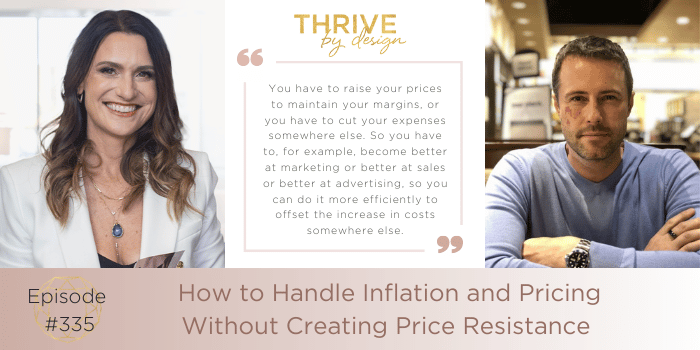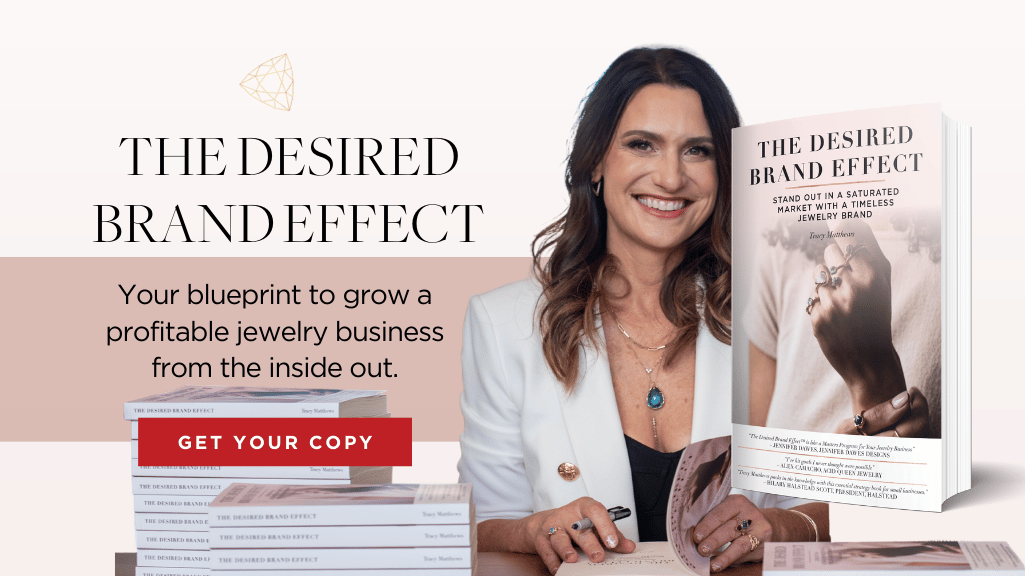EP335: How to Handle Inflation and Pricing Without Creating Price Resistance

When costs go up, you have to raise your prices to maintain your margins or cut your expenses somewhere else.
In this podcast episode, I'll be interviewing Jason Ayers. He is a mindset coach in our Momentum program, my life partner, and an amazing business coach.
He works with $1MM to $10MM companies to help them optimize and streamline their business to increase their profit margins and live a better life doing what they love.
Today, we have a complex and overwhelming topic: inflation. Specifically, how inflation affects your pricing strategy as a jewelry business.
Jason will help us break it down and simplify it as much as possible.
I know pricing is one of the most sensitive topics to talk about and often people's biggest struggle in business.
So today, we're going to help you address this head-on.
Let’s talk about how you should be pricing your jewelry, and how you can feel confident aising your prices without feeling like you're going to repel customers.
What is inflation?
Inflation is essentially a decline in the purchasing power of a given currency over a period of time. With inflation,So your money buys less over time, your money buys less over time.
Let's look at a real quick example.
In the 1980s, one pound of bread cost $0.50. Then in 1990, it was $0.75, and in 2000 it was $1.99. By 2010 that same bread cost $2.99.
So that means something that used to cost $0.50
in the 1980s now costs $3.00 in 2010.
Now, let's say you're retired and have a fixed income that's not adjusting for inflation. And you have your money sitting in the bank. Your money is going to buy less and less every year if inflation occurs.
This is what a lot of people call a hidden tax. Even though you aren’t cutting a check for it, you’re slowly losing money through inflation.
Now, three factors cause inflation. These are demand-pull, cost-push, and built-in inflation.
Demand-Pull Inflation
Imagine that there are 100 high-end designer handbags sold globally on a limited run. Are they going to be more expensive or less expensive than if you were to make 10,000 of those?
Of course, they will be more expensive because they’re scarce and there's more demand.
This is an example of demand-pull inflation.
That's why in the art world, when an artist is deceased, and if they're famous, you're going to have a bunch of people essentially fighting over their art, because the demand just went up..
Cost-Push Inflation
Let's say that you’re a semi-fine jeweler and the cost of silver goes up by 50%. Now you have to factor that cost increase into all of your pieces, and so does every other jeweler..
This is cost-push inflation.
Your only other option is to cut your expenses somewhere else.
You might have to become better at marketing, or better at sales, or better at advertising to be able to do things more efficiently in order to offset the increase in cost somewhere else.
Built-In Inflation
Built-in inflation happens when
wages go up because the cost of living has increased.
For example, lately we're seeing fast-food restaurants offering $18 an hour plus a signing bonus. Normally, you wouldn’t see signing bonuses for entry-level jobs.
We were recently out in California, and I was looking out off the coast of Long Beach pier, and there was a huge line of ships.
There's a supply problem within the United States because the supply is just sitting off the coast. This means we can't buy those things until they get through customs and get put on trucks and trains and everything else and shipped everywhere.
And that creates the demand-pull. Then the supply chain bottleneck is causing a rise in the shipping cost.
Now, we're seeing the cost of materials going up, labor going up, and fewer items going around. Or basically, all three factors that impact inflation.
On top of that, the government has added (printed) about 24% more money by sending checks to aid the economy so that people can afford more goods.
So if you are a producer of goods like a jewelry maker, what are you going to do about your prices?
Profit Margin
Take a good hard look at your profit margins
, especially at the beginning of the year.
This is an excellent time for you to check with your suppliers and deeply analyze your pricing and costing structure. You have to make sure you are properly pricing your products, or you're going to wind up in a tough spot.
This is what happened to a consulting client of mine. She never factored wholesale margins into her retail pricing, so by the time she start booking wholesale clients, she had to sell to them at a loss.
If you sell to stores, you need to make sure that you're making the correct markup on those prices.
Perceived Value
The other thing that I think is important is understanding perceived value.
I interviewed Allyson Hayes from Precious Design Elements in Episode #326. She is a sterling silver designer and primarily sells at in-person shows. And she couldn't figure out why people were walking into her booth saying her pieces were beautiful, only to make a face after seeing the price.
They would say something like, “this must not be real silver.
So in the middle of the show, she tore all the price tags off for her jewelry and doubled all her prices — and sold out every single piece.
Seems crazy, right?
It’s because she elevated the perceived value of each piece to match what the customers thought the piece should cost.
This is especially true if you've created a bunch of demand around your products using The Desired Brand Effect.
Raising Prices and Sales
I get it you may be afraid to raise prices and say, “I'm going to lose sales.” Or, “Although I might make a little more margin, I'm going to make less overall because I'm going to make fewer sales.”
So I want you to consider that maybe if you're getting price resistance, those aren't the right people for you. Those people probably aren't your dream customers and not the people who are necessarily supposed to be buying your jewelry.
I saw this Instagram reel a couple of weeks ago, and it said, “Don’'t tell me that my prices are too high; tell me that it's outside of your budget.”
Because that's really what the case is, and it's not really about you.
But of course, there's a threshold where you might be overpricing your jewelry. You can't charge a million dollars for a silver ring. No one's going to buy that unless Picasso made it.
Rejection Isn’t Personal
One of the challenges when you're raising your prices, especially if you're starting, is that people tend to conflate the designer and the design.
Maybe you feel like…
If I offer this, and someone rejects it, they're rejecting me. Or…If I increase the price, and they reject it, they're rejecting me.
I would invite you to consider that you are the creator, but you are not the creation.
You interact with the marketplace and put things into the market to see how people react to them. Then, you make adjustments to the product. It’s not a personal reflection on you.
So maybe platinum is more popular than silver or vice versa. The only way you'll know is to put it out there and get feedback.
But sometimes, many people will sit at their bench and try to perfect things, and perfect things. But what they're really doing is avoiding rejection.
So, I would invite you to consider that you are not being rejected.
Someone might object to the price or material, but that's just feedback. Use that to dial in to find where that happy medium is between what the market wants and what you can offer. Find the way to build a lot of desire from the market you want to have.
Don’t Shortchange Yourself
Finally, remember that you need to pay yourself a salary. You need to compensate yourself for the work and effort you're putting in. Don't shortchange yourself.
And finally, you have to overcome limiting beliefs because your belief systems ultimately shape your external reality.
Listen to the full episode and discover easy to implement marketing strategies to sell more jewelry without creating price resistance.
xo, Tracy
Follow Jason Ayers on Instagram!
Jewelry Brand Makeover Bootcamp 2022
Episode #326: Perceived Value is an Inside Job with Allyson Hayes
More Resources for Jewelry Designers

